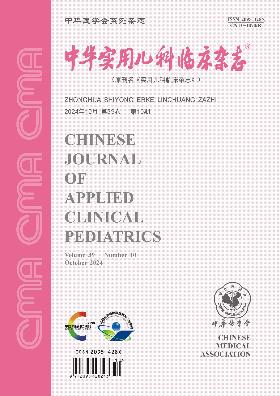Prospective study on effect of new antiepileptic drugs on bone metabolism in children with epilepsy
Q4 Medicine
引用次数: 1
Abstract
Objective To study the effects of new antiepileptic drugs (AEDs), including Topiramate (TPM), Oxcarbazepine(OXC), Lamotrigine(LTG), and Levetiracetam (LEV) monotherapy on bone metabolism in children with epilepsy aged 4-12. Method s One hundred and sixty children with epilepsy who were diagnosed for the first time at Shanxi Children′s Hospital from July 2016 to June 2017 were selected and given oral TPM (40 cases), OXC (40 cases), LTG (40 cases) and LEV (40 cases) respectively according to the type of seizure.The changes of bone mineral density (BMD) and bone metabolism indexes including serum calcium (Ca), phosphorus (P), alkaline phosphatase (ALP), osteocalcin (OC), parathyroid hormone (PTH), 25 hydroxyvitamin D [25-(OH)D] before treatment and at 3, 6 and 12 months after treatment were observed. Result s (1) Bone metabolism indicators and BMD had no significant difference among groups before treatment (all P>0.05). (2) After 6 and 12 months of treatment in OXC group, Ca was lower than before treatment[2.38(0.08) mmol/L vs.2.47(0.17) mmol/L, 2.44(0.10) mmol/L vs.2.47(0.17) mmol/L], PTH was higher than before treatment[37.64(17.52) ng/L vs.34.23(20.53) ng/L, 40.74(16.15) ng/L vs.34.23(20.53) ng/L]; Ca in TPM group decreased after 6 and 12 months of treatment[2.40(0.11) mmol/L vs.2.42(0.10) mmol/L, 2.41(0.09) mmol/L vs.2.42(0.10) mmol/L], and the differences were statistically significant(all P<0.05). (3) After 6 and 12 months of treatment, Ca in the OXC group was lower than that in the LEV group[2.38(0.08) mmol/L vs.2.44(0.10) mmol/L, 2.44(0.10) mmol/L vs.2.44(0.12) mmol/L] and LTG group[2.38(0.08) mmol/L vs.2.44(0.13) mmol/L, 2.44(0.10) mmol/L vs.2.42(0.13) mmol/L], and PTH in the OXC group was higher than that in the LEV group[37.64(17.52) ng/L vs.36.52(20.71) ng/L, 40.74(16.15) ng/L vs.31.89(14.84) ng/L] and LTG group[37.64(17.52) ng/L vs.39.39(24.03) ng/L, 40.74(16.15) ng/L vs.33.01(12.20) ng/L], Ca in TPM group after 12 months of treatment was lower than that in the LEV group[2.41(0.09) mmol/L vs.2.44(0.12) mmol/L] and LTG group[2.41(0.09) mmol/L vs.2.42(0.13) mmol/L], and the differences were statistically significant(all P<0.05). Conclusions In the new AEDs, LEV and OXC have no significant effect on bone metabolism.TPM may affect bone metabolism by reducing Ca in children with epilepsy, and OXC may cause the decrease of Ca and the increase of PTH, thereby leading to increased bone turnover in children with epilepsy. Key words: New antiepileptic drug; Bone metabolism; Epilepsy; Child新型抗癫痫药物对癫痫儿童骨代谢影响的前瞻性研究
目的探讨托吡酯(TPM)、奥卡西平(OXC)、拉莫三嗪(LTG)、左乙拉西坦(LEV)等新型抗癫痫药物单药治疗4 ~ 12岁癫痫患儿骨代谢的影响。方法选取2016年7月~ 2017年6月在山西省儿童医院首次确诊的癫痫患儿160例,根据癫痫发作类型分别给予口服TPM(40例)、OXC(40例)、LTG(40例)、LEV(40例)。观察治疗前及治疗后3、6、12个月患者骨密度(BMD)及血清钙(Ca)、磷(P)、碱性磷酸酶(ALP)、骨钙素(OC)、甲状旁腺激素(PTH)、25-羟基维生素D [25-(OH)D]等骨代谢指标的变化。结果(1)治疗前各组患者骨代谢指标、骨密度差异无统计学意义(P < 0.05)。(2) OXC组治疗6、12个月后,Ca低于治疗前[2.38(0.08)mmol/L vs.2.47(0.17) mmol/L, 2.44(0.10) mmol/L vs.2.47(0.17) mmol/L], PTH高于治疗前[37.64(17.52)ng/L vs.34.23(20.53) ng/L, 40.74(16.15) ng/L vs.34.23(20.53) ng/L];治疗6、12个月后,TPM组Ca含量下降[2.40(0.11)mmol/L vs.2.42(0.10) mmol/L, 2.41(0.09) mmol/L vs.2.42(0.10) mmol/L],差异均有统计学意义(P<0.05)。(3) 6 - 12个月的治疗后,Ca的全光网组低于列弗组[2.38(0.08)更易与L vs.2.44(0.10)更易与L, 2.44(0.10)更易与L vs.2.44(0.12)更易/ L)和LTG集团[2.38(0.08)更易与L vs.2.44(0.13)更易与L, 2.44(0.10)更易与L vs.2.42(0.13)更易/ L),和甲状旁腺素光组高于列弗组[37.64 (17.52)ng / L vs.36.52 ng / L (20.71), (16.15) 40.74 ng / L vs.31.89 (14.84) ng / L)和LTG集团[37.64 (17.52)ng / L vs.39.39 ng / L (24.03),治疗12个月后,TPM组钙含量低于LEV组[2.41(0.09)mmol/L vs.2.44(0.12) mmol/L]和LTG组[2.41(0.09)mmol/L vs.2.42(0.13) mmol/L],差异均有统计学意义(P<0.05)。结论在新型aed患者中,LEV和OXC对骨代谢无明显影响。TPM可能通过降低癫痫患儿Ca来影响骨代谢,OXC可能导致Ca降低,PTH升高,从而导致癫痫患儿骨转换增加。关键词:新型抗癫痫药;骨代谢;癫痫;孩子
本文章由计算机程序翻译,如有差异,请以英文原文为准。
求助全文
约1分钟内获得全文
求助全文
来源期刊

中华实用儿科临床杂志
Medicine-Pediatrics, Perinatology and Child Health
CiteScore
0.60
自引率
0.00%
发文量
14243
期刊介绍:
Chinese Journal of Applied Clinical Pediatrics ( semi-monthly ) is a core journal of paediatrics under the supervision of China Association for Science and Technology, sponsored by Chinese Medical Association and undertaken by Xinxiang Medical College. Founded in 1986, it is openly circulated both at home and abroad. The journal has several columns, such as Expert Forum, Experimental Research and Paediatric Surgery, which are mainly for paediatric medical workers and medical researchers in hospitals. Its purpose is to reflect the new theories and technologies in paediatric medicine and scientific research at home and abroad, and to promote academic exchanges.
Chinese Journal of Applied Clinical Pediatrics is a source journal of China Science Citation Database (CSCD), a core journal of Peking University, a source journal of Chinese science and technology paper statistics (China Science and Technology Core Journals), a core academic journal of RCCSE, a high-quality scientific and technical journal of China, a high-quality scientific and technical journal of China Association for Science and Technology, and a high-quality scientific and technical journal of China Biomedical Science and Technology Association. We have been published in China Biomedical Literature Database (SinoMed), China Knowledge Network, Wanfang Data Knowledge Service Platform, China Academic Journal Abstracts, Scopus Database, Chemical Abstracts (USA), Japan Science and Technology Agency (JSTA) Database, Copernicus Abstracts (Poland), Abstracts of the Centre for Agricultural and Biological Sciences (CABS) of the United Kingdom, Cambridge Scientific Abstracts ProQuest Database, WHO Medical Journal of the Western Pacific Region (WMPR), and WHO Medical Journal of the Western Pacific Region (WMPR) of the United States. We have been included in dozens of authoritative databases at home and abroad, such as WHO Western Pacific Region Index of Medicine (WPRIM), Ullrich's Guide to Periodicals, and so on.
 求助内容:
求助内容: 应助结果提醒方式:
应助结果提醒方式:


